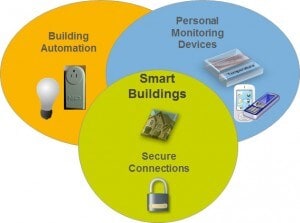We’ve all seen a movie or TV show where a guy walks into a diner, nods
to the waitress and says, “The usual.” The waitress knows
exactly what he means. Without another word, she places his order and, a few
minutes later, brings him exactly the meal he wanted, just as usual.
I want my house to be like that. When I walk into a room, I want the room to
know it’s me and give me “the usual” – my favorite
combination of lights, my favorite room temperature, maybe my favorite
playlist – you get the idea.
Luckily for me, wireless technologies are at a point where this is possible.
Without having to flip a switch, push a button or turn a knob, my
surroundings can know it’s me and can automatically create the
environment I like best. The concept involves low-energy proximity sensing,
which is a technique now supported by two widely used
wireless protocols,
BLE (Bluetooth Low Energy) and
ZigBee.
Beacons for proximity sensing
Here’s how it works: a beaconing device, built into my smartphone,
wristband or some other kind of wearable, sends out a low-energy signal at
regular intervals, in much the same way that a lighthouse or navigational
system does. The beaconing signal contains a unique user ID (UUID), and when I
enter a room, the room’s network receiver picks up the signal and reads
the UUID. The UUID is associated with settings – light levels,
thermostat temperature, and so on – each configured to my liking and
the network automatically uses those settings.
Beaconing is different from GPS. A GPS device only finds my location
coordinates, saying, “Here. Here. Here.” But a beaconing system
provides identification along with the location. It says, “It’s
me, Roman and I’m here.”
Personalized environment
 Beaconing can be used with a wide range of home-automation tasks. For
example, the front door can unlock as I approach, and the alarm system can
turn off as soon as I enter. No more fussing with keys or having to remember a
code for the alarm. Or, if my daughter breaks up with her boyfriend,
there’s no need to rekey the locks, since access is electronically
limited, immediately, at the press of a button. Beaconing can save on utility
bills, too, since anything that uses energy – lights, ceiling fan, gas
fireplace, even holiday decorations – can turn off automatically when I
leave the room.
Beaconing can be used with a wide range of home-automation tasks. For
example, the front door can unlock as I approach, and the alarm system can
turn off as soon as I enter. No more fussing with keys or having to remember a
code for the alarm. Or, if my daughter breaks up with her boyfriend,
there’s no need to rekey the locks, since access is electronically
limited, immediately, at the press of a button. Beaconing can save on utility
bills, too, since anything that uses energy – lights, ceiling fan, gas
fireplace, even holiday decorations – can turn off automatically when I
leave the room.
Adding sensor technology to the mix makes it possible for settings to change
as my situation changes. Let’s say I just went for a run –
I’m hot, and I don’t want the room to be as warm. The network
can sense this, and lower the thermostat until my body temperature returns to
normal. The same is true if I’ve been sitting for a while: the network
can sense my body temperature is lower, and turn up the heat a few degrees to
compensate.
True automation
Beaconing promises to deliver on my vision of a truly automated home. After
all, I want to be warm, without bothering with the thermostat, and I want my
lighting to be just right, with my preferred color settings and illumination
levels, without fumbling with switches. In other words, I want to be the guy
who gets the usual, simple as that.


 Beaconing can be used with a wide range of home-automation tasks. For
example, the front door can unlock as I approach, and the alarm system can
turn off as soon as I enter. No more fussing with keys or having to remember a
code for the alarm. Or, if my daughter breaks up with her boyfriend,
there’s no need to rekey the locks, since access is electronically
limited, immediately, at the press of a button. Beaconing can save on utility
bills, too, since anything that uses energy – lights, ceiling fan, gas
fireplace, even holiday decorations – can turn off automatically when I
leave the room.
Beaconing can be used with a wide range of home-automation tasks. For
example, the front door can unlock as I approach, and the alarm system can
turn off as soon as I enter. No more fussing with keys or having to remember a
code for the alarm. Or, if my daughter breaks up with her boyfriend,
there’s no need to rekey the locks, since access is electronically
limited, immediately, at the press of a button. Beaconing can save on utility
bills, too, since anything that uses energy – lights, ceiling fan, gas
fireplace, even holiday decorations – can turn off automatically when I
leave the room.


